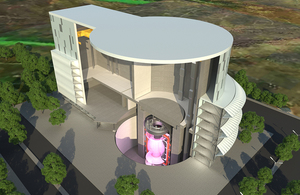UK's prototype fusion energy plant is one step closer to finding a home
The initial list of sites being considered for the STEP plant has been published

Conceptual illustration of the STEP fusion power plant
-
An open call for sites to host UKAEA’s prototype fusion energy plant was announced in December 2020 and nominations closed at the end of March 2021.
-
Following an initial assessment for compliance with the key entry criteria, UKAEA has now published the long list of nominated sites.
-
Moving fusion from research and development to design and delivery is an important part of the UK’s ambition to be a world leader in sustainable, low-carbon energy.
Fifteen sites are in the running to become the future home of the UK’s prototype fusion energy power plant – the Spherical Tokamak for Energy Production, or STEP.
The sites, listed here from North to South across the UK, are:
| Site | Nominating entity |
|---|---|
| Dounreay | Caithness and North Sutherland Regeneration Partnership |
| East Airdrie | Fusion Forward (East Airdrie) Consortium |
| Poneil | Fusion Forward (Poniel) Consortium |
| Ardeer | Fusion Forward (Ardeer) Consortium |
| Chapelcross | South of Scotland Enterprise |
| Moorside | Cumbria Local Enterprise Partnership, in partnership with Copeland Borough Council |
| Bay Fusion (Heysham) | Bay Fusion (collaboration between industry, Lancaster City Council, Lancashire County Council and Lancaster University) |
| Goole | East Riding of Yorkshire Council |
| West Burton | Nottinghamshire County Council |
| Ratcliffe on Soar | Nottinghamshire County Council |
| Milford Haven | Pembrokeshire County Council |
| Severn Edge (Oldbury/Berkeley) | Western Gateway |
| Aberthaw | Vale of Glamorgan Council |
| Bridgwater Bay | Heart of the South West Local Enterprise Partnership |
| Bradwell | Belport Ltd |
Acceptance of these sites into our assessment process does not indicate they are preferred or desired, or that we believe their development is, in all cases, possible – simply that the procedural entry criteria have been met and assessment has now begun. Inclusion is without consideration of adjacent operations or proposals.
Many sites have adjacent operations, bringing mutual dependencies if STEP were to be developed in those locations. We will work to understand the dependencies and implications as the assessment continues. No view will be formalised on the potential suitability of sites until the shortlisting phase, which will take place in the autumn.
The successful site for STEP will become a global hub for fusion energy and associated industries, creating thousands of highly skilled jobs during the construction and operation of the plant, while attracting investment that will enable the development of a new UK science and technology centre of excellence.
Fusion has the potential to provide an abundant source of low-carbon energy by copying the processes that power the sun and stars. This exciting new technology will play an important role alongside established renewable technologies such as wind and solar.
STEP will be the UK’s prototype fusion plant and is intended to pave the way for commercial fusion power. UKAEA is targeting first operations in the early 2040s, with initial aims to produce a concept design by 2024.
The next stage of the process is a thorough technical assessment to assess the comparative suitability of the sites. Once all assessment processes are complete, the Secretary of State for Business, Energy and Industrial Strategy will make a final decision on the site; anticipated around the end of 2022.
STEP Programme Director, Paul Methven said:
STEP is about building on the amazing science done over decades in fusion and translating that into a real prototype power plant that paves the way for this fantastic new energy source.
Selecting a site is critical for that transition to delivery and we are pleased to have received a number of high quality nominations. We are looking forward to getting to know the nominating communities as we progress through the assessment process over the next year.
Wherever STEP is eventually built, it will bring significant benefits to the region, including employment, skills development and the development of a high-technology, low-carbon supply chain.